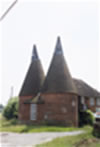|
Introduction
One of the most
familiar sights and one that is puzzling to first time visitors to
southeast England is the distinctive brick or stone built barns with
their round or square towers topped by conical white cowls. These
oast houses are a reminder of Britain's once thriving brewing
industry.
Oast Houses are mainly found in Kent and parts of
East Sussex, which were the heart of the hop growing industry in
England. Kent proved to have ideal soil for growing hops, and plenty
of wood for the charcoal used in oast houses to dry the hops.
History of brewing
Ale has been brewed
in England since Roman times, if not earlier, and many households,
especially in the countryside, would have brewed their  own ale. Each
inn would also have brewed their own drink, which would be
distinctive and peculiar to that hostelry. Ale was made from
fermented malt, but in the 15th Century beers started to be
introduced from the Low Countries that introduced the use of hops to
add flavour and aroma and from this the English drink of bitter was
developed. Very quickly hops started to be grown in Kent and a
brewing industry started to emerge in nearby London. own ale. Each
inn would also have brewed their own drink, which would be
distinctive and peculiar to that hostelry. Ale was made from
fermented malt, but in the 15th Century beers started to be
introduced from the Low Countries that introduced the use of hops to
add flavour and aroma and from this the English drink of bitter was
developed. Very quickly hops started to be grown in Kent and a
brewing industry started to emerge in nearby London.
The
brewing industry grew rapidly in the 17th and 18th Centuries. By
1700 commercial breweries had almost entirely replaced the practice
of inns brewing their own beverages, and by 1840 there were over
50,000 separate breweries. However, just 40 years later that number
had dropped by half and by the turn of the 20th century only about
3,000 breweries were left. Today, after further consolidation there
are only about 20 national brewers, some 250 independents and about
150 pubs that brew their own beer, resurrecting the old practice of
brewing on site.
Hop Growing
Oast houses
were designed to facilitate drying the female flowers of the
climbing hop plants, which became a vital ingredient of the brewing
industry as the beer took over from ale as the popular English
drink.

As bitter grew in popularity, commercial growing
techniques for hops were developed. Hops were grown in 'gardens,'
which consisted of a wire framework suspended above chestnut posts.
From these wires lengths of string were suspended and the shoots of
the hop plants were trained up these strings from the hop crowns,
planted in the ground. The gardens were strung and maintained by
stilt-walkers (a highly specialised job) and the mature hops were
harvested by hand in August.
The picking of the crop was
very labour intensive and in order to ensure that the hops were
picked many workers came from London and stayed in hoppers huts,
treating the whole experience as their annual holiday. For many
Londoners this would be their only experience of life outside the
town and it was a particularly basic existence. The picking was organised by bin-men and paid by the 'tally' -- a token system based
on the number of baskets or 'bins' picked by each person.
Once picked, the hops needed to be dried on the day of
harvest, and this explains why there are so many oast houses in the
main hop growing areas.
Oast Houses
An
oast consists of a 'barn' section, together with the distinctive
'kiln' or 'roundel.' Many oasts had more than one roundel and
Summerhill Oast is an excellent example of a two roundel oast.

Fresh hops from the gardens were unloaded and taken upstairs
in the barn section from where they were taken into the roundel, the
upper floor of which consisted of a latticed floor of wood and wire
onto which the green hops were laid. A fire was lit below and the
air channelled through the floor to dry the hops. The distinctive
conical roof of the oast is necessary to create a good draught for
the fire. The characteristic projections at the peak of the roof are
cowls, the fingers of which act like a wind vane so that they rotate
to always have their backs to the prevailing wind, thereby creating
just the right airflow for the kiln fire to draw properly and to
ensure that the humid air driven off the crop was channelled to the
outside. Kilns were fired by wood until the 17th century, then by
charcoal and in the 19th century by coal or coke, but later gas and
oil-fired burners took over. Before the use of gas or oil the task
of maintaining the correct amount of heat to suit the particular
crop was considered to be a very skilful job and specialists, called
Oasties were employed for the duration of the hop harvest.
The dried hops were then raked out into the upper floor of
the barn section to cool before being packed and pressed into large
Hessian sacks called pockets, which hung under square holes in the
upper floor of the barn section. Above these holes were presses that
were used to force the dried hops down into the pockets. Two of
these square holes are still visible in Summerhill Oast. The lower
floor of the barn area would also have been used to store implements
used for harvesting and carts to take the pockets of dried hops
away.
The earliest oast kilns were merely converted barns,
but then specialised buildings started to evolve, which were usually
build with square towers, which were easier to construct. Sometime
around 1840 hop growers decided that round kilns would be more
efficient, giving a better heat distribution, with no cold corners.
Consequently this became the most common design and many of the
surviving oasts, of which Summerhill Oast is one, have the round
kilns, or roundels. Later on, around 1890, science proved that
square kilns were more efficient after all, as well as being cheaper
to build, and, as a result, the later oasts are almost all of square
design. The familiar and most recognisable feature of the oast
house, the white conical cowl with its finger, often decorated with
a Kentish Invicta or other design, was replaced as oil and gas fired
kins became more common, because they did not have the same
requirement for a through draft. Some oasts, particularly on the
Kent Sussex border have a simpler, squatter, wooden  chimney type of vent.
chimney type of vent.
In recent years the acreage devoted to growing hops in
Britain has fallen dramatically, as imported hops flood the market
and hops are today dried industrially. This initially left abandoned
oast houses scattered across the former hop growing areas, but in
the last twenty years or so many of these historic buildings have
been converted for other uses and are particularly desirable as
houses. Even those that remain on farms are seldom used for their
original purpose, often becoming simply sheds for storage or stables
for horses, indeed Summerhill Oast, part of Summerhill Farm, was
used variously as a cow shed and an implement shed until its
conversion in 1992.
|